Yamaha synthesizer design
- Home
- 40th Anniversary Model
- History
- Chronology
- Product Lineup
- News
- Artist Comments
Yamaha synthesizer design
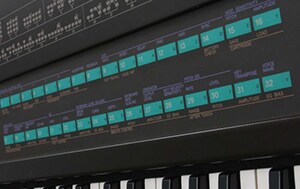
Within Yamaha, the Design Laboratory is responsible for product design. This organization came into being when the Packaging Section of the development section was reformed as an independent department, and now employs approximately 25 designers who are tasked with designing a broad range of products, including grand pianos, guitars, golf clubs, audio products, and soundproof rooms. Although Yamaha may sometimes ask other organizations to design its products, almost all synthesizers are designed and created in-house. Here, we take a look back on the synthesizers that Yamaha has given the world, with a particular focus on design.
The player's view; the audience's view

GX1
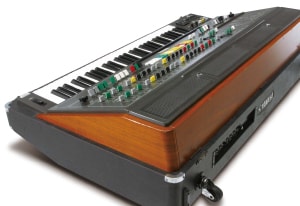
CS80
Yamaha's first synthesizer, the SY-1 (1974) was an instrument developed as a solo-part keyboard for the Electone®. It featured a panel layout that made it easy to perform with while playing the Electone of the day, its parent instrument and an overall design that matched its parent instrument, the Electone of the day. Released the following year in 1975, the GX-1 was a groundbreaking instrument that featured the same number of tone generators as 35 typical synthesizers of the day. The instrument and stool were joined, enveloped in white, and supported by legs emblazoned with chrome so that the GX-1 and player appeared to float above the stage. Of course, since no instrument is complete without someone to play it, the stool has a movable design, allowing the player to assume an appropriate posture for performance. The sound and form of the GX-1 gave a futuristic impression, as if to convey that a new form of music was arriving.
In the analog synthesizer era, tone generators took up a lot of space, and despite the various limitations such instruments were subject to, usability was a serious consideration. The flagship model CS-80 that Yamaha released in 1977 came with a case fitted with casters for easy portability, and featured a distinctive array of buttons on the control panel. Utilizing wood on the rear and side panels conveyed an impression of heavy-duty reliability, and gave the CS-80 a feeling of warmth. With the arrival of the eighties, the move to digital technology prompted a reduction in the size of synthesizers, and with it a change in their outward appearance. 1982's CS01 featured a voice memory that had been converted to digital, a mini-keyboard, battery power source, and built-n internal speakers, and while improving the freedom available to keyboard players on stage, it was also aimed at youth culture of the day that stressed the need for lightness. Players could hang the CS01 from a shoulder strap for a "cool" look onstage that was emphasized by the simple panel layout and light-blue printed "CS01" graphic on the instrument's grey body.
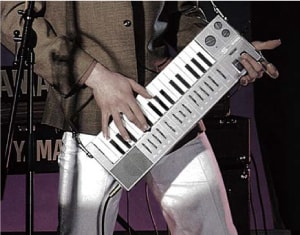
The CS01 featured pitch bend and modulation wheels at the corner of the instrument body for ease of use when standing while playing.
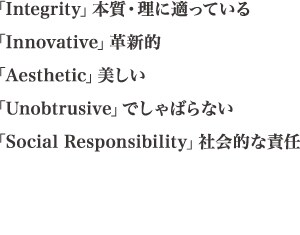
The design philosophy behind Yamaha products is made up of five elements, and every product we make could be said to be the embodiment of this philosophy.
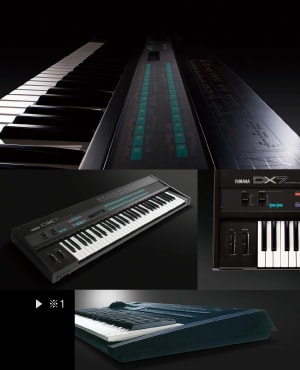
*1 Released in 1987, the DX11(V2) featured a front panel that was slimmer than the instrument keyboard. The body of this synth was constructed of aluminum, giving the instrument a total weight of 6.9 kg and a solid feel that belied its slim configuration.
What changed the synth world completely was the arrival of the enormously popular DX7, which utilized LSIs to dramatically reduce the number of parts required and make the instrument more compact. The DX7 featured a flattened operations panel that allowed the audience an unfettered view of the player's hands on the keyboard when on stage. The design eliminated three-dimensional buttons and levers in favor of flat, membrane switches embossed with green graphics, arrayed in a simple layout; an appearance that was intended to make a strong impression on players as the world's first digital synthesizer. The use of membrane switches, something that is rare in instruments, offered many choices in terms of printing coloration, with designers electing to utilize a green that would look attractive against the dark brown body color—the same dark brown as was used for the personal computers that Yamaha was selling at the time. Referred to as "DX green," this was a symbolic color that went on to make occasional appearances in Yamaha synthesizers.
The DX7 was also the first Yamaha synthesizer to feature the Yamaha logotype and product logo on the back of the instrument where the audience can see it easily. The use of digital technology lowered the "wall" formed by the operations panel in earlier synthesizers, creating an awareness not just of what the player sees, but also how the synthesizer and player appear to the audience. These two factors continued to be important themes in the design of Yamaha synthesizers in the years that followed.
Responding to a growing range of needs

The unique textures on the sides of the YS200.
In the latter half of the eighties synthesizers moved into the mainstream. No longer solely the domain of mostly male, professional and semiprofessional musicians, synthesizers aimed at beginners began to make an appearance in the market. Released in 1988, the YS200 featured a unique operations panel, and was born from a philosophy called "Product Semantics," in which designers express the function of products through their form. In order to make synthesizers appear more readily understandable, Yamaha designers arrayed controls for music data loading, volume, voice selection, adjustment, and lastly, output, along a groove extending from the left to right of the panel, attempting to express the flow of music production and surround the instrument in familiarity. This expression was also found in portable keyboards of the era.

YS200
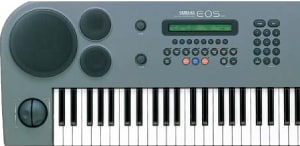
B200
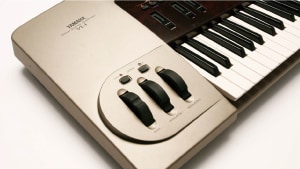
At the same time, Yamaha was introducing product groups aimed at beginner and intermediate players into the market, with the B Series (EOS) finding particular success in Japan. The B200, which went on sale in 1988, offered functions specifically tailored to players who were just starting out and featured two-way circular speakers at the top of the operations panel, rounded corners at the upper left and right of the instrument body, and spherical modulation and pitch-bending wheels that fit the hand comfortably. This use of rounded form became an iconic motif for the EOS, which was a product developed from a completely different standpoint to those instruments geared towards more professional use. From 1988, when the B200 was released, through to 2007, Yamaha held an EOS contest judged by such notables as Tetsuya Komuro and Daisuke Asakura, bringing attention to the field of synth-based music production. The EOS series found favor with teenagers and women in their twenties, with product planning and marketing working together to develop the instrument, heralded an era in which design also worked to respond to a range of different requirements.
The VL1 debuted in 1993 as a virtual acoustic synthesizer, featuring a body with uniquely warm lines quite different from other Yamaha synthesizers to date, giving it a softly three-dimensional feel from any angle. While other companies were using PCM tone generators, the VL1 featured a VA tone generator based on a world-leading physical modeling system that analyzed the sound creation structures of acoustic instruments. What design would suit a new synthesizer that utilized VA tone generation to reproduce wind and string instruments with such realism? This was a true Yamaha approach, and resulted in a design with gentle curves and a champagne gold body, themed around the image of acoustic instruments. The operations panel was crafted from the same interior wood paneling used for luxury vehicles, utilizing the wood crafting techniques used in piano production to give the VL1 an acoustic warmth. As Yamaha produces both acoustic and digital instruments, our in-depth knowledge of both gave us the insight and know-how to create this unique design.
Respect for pioneers

EX5
As the decades passed, each new synth that Yamaha produced drew on the legacy of previous models in some way or other during development. 1998's EX5 was created to be a next-generation synthesizer equipped with five different tone generators, including VA synthesis, and featured a body with a curved left side that paid tribute to its VA pedigree.
First appearing in 1976, the CP Series began with the CP-30 Electronic Piano with its analog tone generator, and the CP-70 Electric Grand (which utilized a plucked string tone generator) and later evolved into a series of stage pianos. The flagship model CP1 released in 2009 was a superbly expressive instrument that continued this legacy, utilizing SCM tone generation, and comes with the voices of the CP-70 and CP-80 vintage electric pianos as internally-stored tones. It features an aluminum panel designed in the image of a Japanese sword, which reflects the keys of the keyboard and serves to heighten the player's concentration. It also features a specially treated coated leather effect panel fascia that creates a pleasing texture and resistance. With knobs that respond firmly to the player's touch and solid wood panel sides that stand up to the rigors of touring, the CP1 boasts a shining Yamaha logotype that is readily visible to the audience. This exterior is reminiscent of a high performance machine, signifying the new directions that the CP1 will take those who play it.
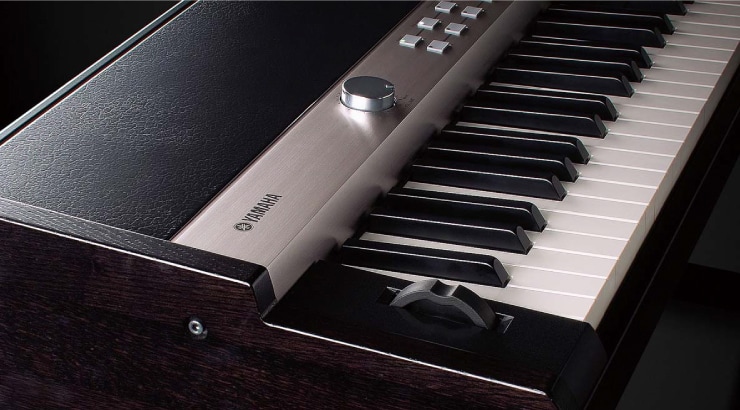
CP1
Connecting the player and audience
Product design customarily begins by working with other staff to decide on concepts. One day in 2000, design and development personnel, a producer, and a designer met with five professional synth players to ask their opinions on a number of different areas in order to gather information for new product development. At the time, Yamaha synthesizers were mired in crisis, and, spurred on by an awareness of impending difficulties, we were searching for a way to put ourselves back on an upward trajectory. From these discussions emerged the factor that players themselves are aware of where the audience is looking. Workstations with an almost transparent aspect to their identity—instruments that emphasize the appearance of the player on stage—addressed this issue of the relationship between the view experienced by players and that of the audience, which has been a common theme linking Yamaha synthesizers since the time of the DX7.
Indeed, this theme was the impetus behind the design of the MOTIF® workstation that Yamaha released in 2001—an instrument aimed at professional musicians that is also attractive for others to look at. The silver body color and edged sidelines of the MOTIF design seem to embody the sharpened senses of the player, while the black line extending from the operations panel to the rear of the instrument served as a connection between the player and the audience, and became the symbolic heritage of the MOTIF series.
With the same sort of internal systems found in a normal PC and OS, the MOTIF X, the third generation in the MOTIF series, featured a radically altered interior and made it possible to engage in an even broader range of music production activities, and thus brought with it further changes in control panel layout. This new MOTIF was equipped with eight sliders and knobs arrayed in the vertical panel stripe that is part of the MOTIF DNA, expressing the constant link between the player and audience. A new line drawn horizontally on the panel enclosed the music editing operation buttons to convey an awareness of the production flow, while lateral parts were placed to the left and right of the operations panel, allowing users to concentrate on music production. As other makers were now releasing a multitude of silver colored synthesizers onto the market, Yamaha designers switched to using a metallic green body color that recalled the green of the monitor screens used when digital technology was in its infancy. A two-tone color scheme was used at the rear of the instrument so that the slim operations panel appeared to float when on stage.
In the planning stages of the MOTIF XS the personnel involved spend a great deal of time involved in repeated discussions in which one keyword came up repeatedly: "Spy." The movie "Mission Impossible 3" was popular at the time, and it's true to say even now that the designers were inspired by the image of the thrilling actions of the protagonists, which were professional and stylish.
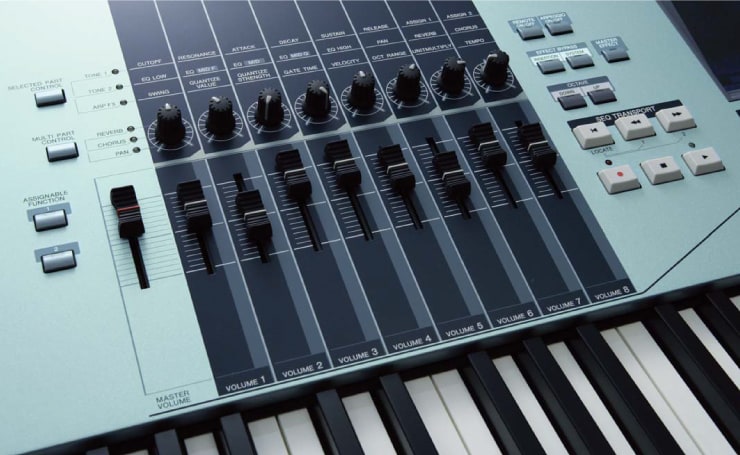
MOTIF XS
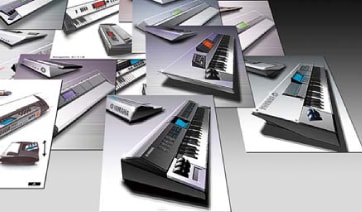
Design sketches for the first-generation MOTIF.

The MOX was released in 2011, intended to be a popular model that would continue the heritage of MOTIF sound and functionality. A high level of cost-performance was demanded of the MOX, and consequently resin was used for the instrument body. In the midst of such restrictions, many meetings were held with production personnel in order to realize the "smoothness" that was touted as a concept for the product. That's why we chose to utilize processes only possible with plastics to assemble the two different types of sides and rounded rear surface panels, making good use of indentations in the panel surfaces.
There is no end to the stories of design inspiration, and even if a product is superbly designed there is no guarantee that it will be a hit. Products are created from a fusion of ideas and technologies from planning, development, research, sales, and marketing, as well as from design. Musical instruments are interfaces through which players convey music to the audience, a core concept that to which Yamaha synthesizers have stayed true for an unbroken 40-year period, and one that they will remain faithful to in the future.





